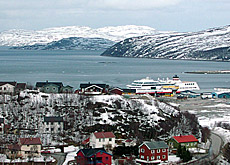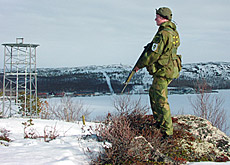All quiet on the Arctic Schengen border

Army conscripts and police keep a close eye on Norway’s only official crossing point into Russia at the northernmost external border of the Schengen area.
swissinfo visited Kirkenes to find out why the Swiss are taking an interest in this chilly outpost thousands of kilometres from home.
It is still wintry here at the end of April and the hills are covered in snow. The main roads are clear and the wind is chasing a few clouds across the blue sky.
Above the Arctic Circle, Kirkenes seems little more than a provincial town at the end of civilisation.
But it marks the northern boundary of the so-called Schengen area, a territory without borders which stretches across 15 European countries.
The Swiss are due to decide whether to become part of Schengen in a nationwide vote on June 5.
From Kirkenes it is 5,500km to Tarifa, the Spanish town at the southernmost tip of the passport-free zone. Much closer is the Russian city of Murmansk, which is only 250km away. Since the collapse of the Soviet Union in the early 1990s the flow of people and goods in the Barents Sea region has picked up.
Norwegian border guards and the police are in charge of monitoring the 196km border with Russia which runs along the Pasvikelva River.
“It is a very peaceful and quiet border. Life is rather slow but the climate can be harsh, especially in winter when it’s dark for 24 hours,” said Per Gunnar Østeraas, second in command of the border guard unit at the Sør-Varanger garrison just outside Kirkenes.
Tourists, boats and reindeer
The authorities recorded 46 border incidents last year, mostly in the summer season, and mainly involving tourists who stepped across the border in violation of a 1949 treaty with Russia.
“If we catch them, we hand them over to police and they have to pay a fine of 5,000 Kroner [$800],” said Østeraas.
Other incidents include fishing boats drifting into Russian waters or reindeer herds ignoring man-made demarcations.
Army conscripts survey the border from observation posts and on patrol with off-road vehicles, sometimes on foot or if necessary by helicopter.
In winter skis, snowmobiles and special night-vision goggles are used to spot suspicious activities in the white wilderness.
New cabins and observation towers were built to conform to standards set by the Schengen treaty.
The 150-strong unit of the Norwegian army works in close cooperation with local police, but recently there have been no major incidents involving people trying to cross the green border into Norway.
Busy checkpoint
There is a steady flow of traffic at the Storskog border checkpoint, 14km outside Kirkenes.
The number of vehicles crossing between Norwegian and Russian territory increased from a mere 259 in 1990 to 31,285 in 2004.
Most of them were Russian tourists on a shopping spree or other business, or fishermen who keep their boats in Kirkenes. But increasingly Norwegians are travelling to Russia for salmon fishing and camping.
According to Lars Gaupset, police superintendent at the Storskog border crossing point, the main advantage of the Schengen treaty is that his officers are now linked up to a European-wide information database, the Schengen Information System (SIS).
“It’s going smoothly. The SIS is easy to use and quick, and we have complete control of all the people crossing here.”
His station, which is open from 7am to 9pm, houses a separate customs unit and is equipped with computers and a device to detect radioactivity.
He welcomes the close cooperation with border guards, in particular the Finnish frontier guard – a highly qualified and experienced unit, stationed about 150km to the south of Kirkenes.
Gaupset hopes that the SIS – including the finger-printing database for asylum seekers, Eurodac – and tight controls at external Schengen frontiers will make up for scrapping systematic identity checks at internal European borders.
“Criminals take advantage of the open borders, that is a big challenge for us,” he said.
Organised crime
Officials say the Schengen system has not led to an increase in crime or illegal immigration in northern Norway.
But Kirkenes police chief Ketil Haukaas admits improvements to the SIS are necessary in order to step up checks on vessels at sea.
He said a wave of petty crime, along with social problems as a result of an influx of prostitutes from Russia, initially upset the local population but have since been brought under control.
The authorities also uncovered a major network of car smugglers who operated in central Europe and used the border crossing in northern Norway to drive across to Russia in the 1990s.
The fight against international organised crime remains a priority for the authorities in Kirkenes.
They are also concerned about Russian plans to reduce the number of staff at their border, and the intention to let a barbed-wire fence – a remnant of the Cold War – disintegrate.
“All this puts pressure on Norway to maintain the current level of border surveillance and ensure stability,” said Colonel Leif-Arne Ljøkjell, the Norwegian Border Commissioner who acts as top liaison officer for contacts with the Russian side.
Kirkenes, a strategic town that was razed to the ground during the Second World War, has high hopes for the future.
It is not so much rumours that a foreign investor wants to bring the iron-ore mine that closed down in the mid-1990s back to life, but expectations that the town could one day become a thriving centre for the oil industry.
That has been a dream of the people here since the Russians and Norwegians both set their sights on the Barents Sea several centuries ago.
swissinfo, Urs Geiser in Kirkenes
In 2004 there were 46 violations of the 1949 Russian/Norwegian border treaty.
Most incidents involved tourists illegally setting foot on Russian territory along the border.
The number of people crossing the border increased from 8,259 in 1990 to 131,145 in 2004 before the figure dropped to 108,188 last year.
The number of cars passing the Storskog checkpoint rose from 259 in 1990 to 31,285 in 2004.
Kirkenes is 2,480km northeast of Oslo on the Barents Sea. The region is near the northernmost external border of the European Schengen area.
The Norwegian/Russian border is 196km long and has one official road checkpoint outside Kirkenes.
On the Norwegian side there are six border stations as well as a series of observations posts manned by about 150 army conscripts working as border guards.
The electric fence with barbed wire on the Russian side was meant to stop people from leaving the Soviet Union during the Cold War.

In compliance with the JTI standards
More: SWI swissinfo.ch certified by the Journalism Trust Initiative


You can find an overview of ongoing debates with our journalists here . Please join us!
If you want to start a conversation about a topic raised in this article or want to report factual errors, email us at english@swissinfo.ch.